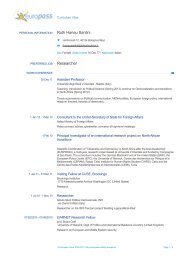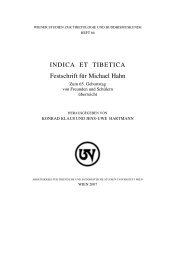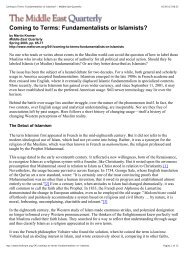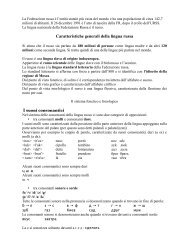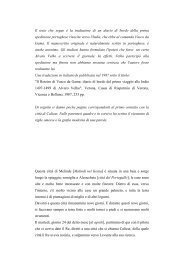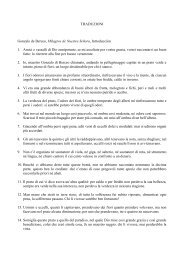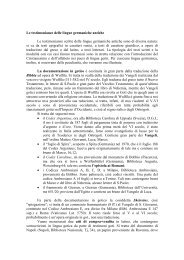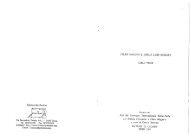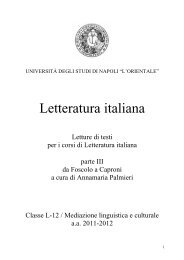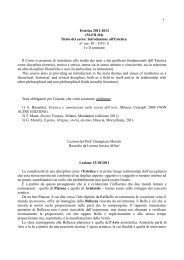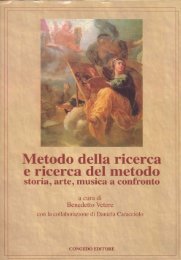You also want an ePaper? Increase the reach of your titles
YUMPU automatically turns print PDFs into web optimized ePapers that Google loves.
According to the LKC (V, 115), the signs are ten 25 ; these are divided<br />
into two groups, on the. basis of the place in which the yogin practises. His<br />
practice can be performed either in a open space or in a closed space. In<br />
the former case it is called day-yoga, in the latter case night-yoga. During<br />
the night-yoga, that is, during the yoga performed in darkness (see below<br />
pp. 276-77, 292), four signs appear from a cloudless sky: smoke (dhUma),<br />
mirage (marIcl), firefly (khadyota) and lamp (pradipa). During the dayyoga<br />
(see below pp. 276-78, 292) six signs appear: flame (jviillf), moon<br />
(cancb:a), sun (arka), Riihu, lightning (vidyut) and bindu, which is similar to<br />
a blue lunar disc that illuminates all things. According to the SU (st. 26),<br />
when this last sign has arisen the yogin can see and then meditate on a last<br />
apparition in the middle of it, which is technically called the 'universal<br />
image' (visvabimba; Tib., sna tshogs gzugs). This text does not mention a<br />
'Buddha's image' (buddhabimba; Tib., sangs rgyas gzugs) and 'void<br />
image' or 'image of the void' (sunyabimba; Tib., stong pa'j gzugs), which<br />
appear in the same context in other sources, such as the LKC and the<br />
LTT26.<br />
belongs to the contemporary Theravada tradition, I am quoting here an extract from one of<br />
his books, as interesting comparisons can be made with the subject matter we are discussing<br />
here. "Now, the breath refines and calms further when We create a mental image (nimitta) at<br />
the guarding point. This mental image is only imaginary, it is not real. It is created by the<br />
citta, it is mind-made. You can close the eyes and 'see' it. It is like a hallucination that the<br />
mind creates by itself to calm the breath. To do so, the mind must be subtle. The breath,<br />
everything, must be refined in order to raise a mental image. The breath must become finer<br />
and calmer until the image is created. The mental image can be any kind of shape or form,<br />
depending on what is appropriate for the body of each person. Some people might create a<br />
sphere - red, white, green, or any color. It could be a candle flame, for instance, or a puff of<br />
cotton, or a wisp of smoke. It can look like the sun, or the moon, or a star. Even the image<br />
of a spider's web glimmering in the sunlight is within the abilities of the mind's creative<br />
powers. The kind of image depends on the one who creates it. The mind merely inclines in<br />
a certain way and the image arises by itself. It is a purely mental phenomenon that has no<br />
physical reality" (1989: 41-2).<br />
25 It is worth mentioning that according to Naropa and Ravisrijfiana during the<br />
anusmrti the ten signs appear again and are related to the ten phases of love described in<br />
LKC IV, 126 (below pp. 104,266 note 82).<br />
26 While considering the Sanskrit texts of the Kalacakra, we have to note that<br />
sometimes the three terms visvabimba, buddhabimba - which conesponds to the realization<br />
of Buddha's body of enjoyment (sambhogakaya) - and siinyabimba are sometimes used as<br />
synonyms and sometimes not. As a matter of fact, in LKC V, 115 (and VP, where NS 61c-<br />
63b is quoted) we find mention of the buddhabimba, but not of the visvabimba, whereas<br />
commenting on NS 6Ic-63b, in both the LTT and the pilkinijiilasarpvararahasya (which is<br />
mostly based on the L TT), we find the compound sarvakiiratraidhiitukapratibhasa<br />
23



